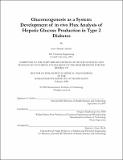| dc.contributor.advisor | Gregory Stephanopoulos. | en_US |
| dc.contributor.author | Alemán, José O. (José Orlando) | en_US |
| dc.contributor.other | Harvard University--MIT Division of Health Sciences and Technology. | en_US |
| dc.date.accessioned | 2008-12-11T16:56:48Z | |
| dc.date.available | 2008-12-11T16:56:48Z | |
| dc.date.copyright | 2008 | en_US |
| dc.date.issued | 2008 | en_US |
| dc.identifier.uri | http://hdl.handle.net/1721.1/43743 | |
| dc.description | Thesis (Ph. D.)--Harvard-MIT Division of Health Sciences and Technology, 2008. | en_US |
| dc.description | This electronic version was submitted by the student author. The certified thesis is available in the Institute Archives and Special Collections. | en_US |
| dc.description | Vita. | en_US |
| dc.description | Includes bibliographical references (p. 289-300). | en_US |
| dc.description.abstract | Metabolic diseases are an increasing health concern in the developed world. Type 2 Diabetes, (T2D) affects over 100 million people worldwide and significantly contributes to chronic diseases such as atherosclerosis and kidney failure. This condition is characterized by deregulation of glucose homeostasis through the development of insulin resistance, manifested as increased glucose production in the liver. Hepatic gluconeogenesis provides de novo formation of glucose from three carbon precursors such as glycerol, lactate, pyruvate and alanine. The upregulation of this pathway underlies the persistent hyperglycemia observed in diabetic patients. We have developed stable isotope tracer methods to reconstruct hepatic glucose production fluxes by infusion of [13C, 2H]-glycerol and mass spectrometry analysis of plasma metabolites. Using this methodology we observe physiologic changes in liver cell lines and primary hepatocyte cultures in the presence of hormones insulin/glucagon and in response to gluconeogenic precursor availability. We put forth the hypothesis that in the presence of glycerol as a gluconeogenic substrate, glucose-6-phosphatase has an important role in modulating metabolic flux through upper gluconeogenesis. Infusion of simultaneous tracer combinations in vivo including a novel [U-13C,2H5]-glycerol allow detailed net flux and reversibility reconstruction of upper gluconeogenesis to an unprecedented degree in a single experiment. We deployed the developed methods to probe glucose overproduction in the liver insulin receptor knockout (LIRKO) transgenic model of Type 2 Diabetes, and found unexpected similarities in the metabolic flux profile not observed by genomic, protein or metabolite measurements. | en_US |
| dc.description.abstract | (cont.) Our results underscore the importance of flux measurement as a physiologic parameter akin to gene and protein expression in revealing the metabolic phenotype of cells, tissues and organisms. These methods have the potential to contribute as clinical assays to characterize excess glucose production as well as in drug development for new targets to control hepatic glucose production. | en_US |
| dc.description.statementofresponsibility | by José O. Alemán. | en_US |
| dc.format.extent | 333 p. | en_US |
| dc.language.iso | eng | en_US |
| dc.publisher | Massachusetts Institute of Technology | en_US |
| dc.rights | M.I.T. theses are protected by
copyright. They may be viewed from this source for any purpose, but
reproduction or distribution in any format is prohibited without written
permission. See provided URL for inquiries about permission. | en_US |
| dc.rights.uri | http://dspace.mit.edu/handle/1721.1/7582 | en_US |
| dc.subject | Harvard University--MIT Division of Health Sciences and Technology. | en_US |
| dc.title | Gluconeogenesis as a system : development of in vivo flux analysis of hepatic glucose production in Type 2 Diabetes | en_US |
| dc.title.alternative | Development of in vivo flux analysis of hepatic glucose production in Type 2 Diabetes | en_US |
| dc.type | Thesis | en_US |
| dc.description.degree | Ph.D. | en_US |
| dc.contributor.department | Harvard University--MIT Division of Health Sciences and Technology | |
| dc.identifier.oclc | 263175720 | en_US |
